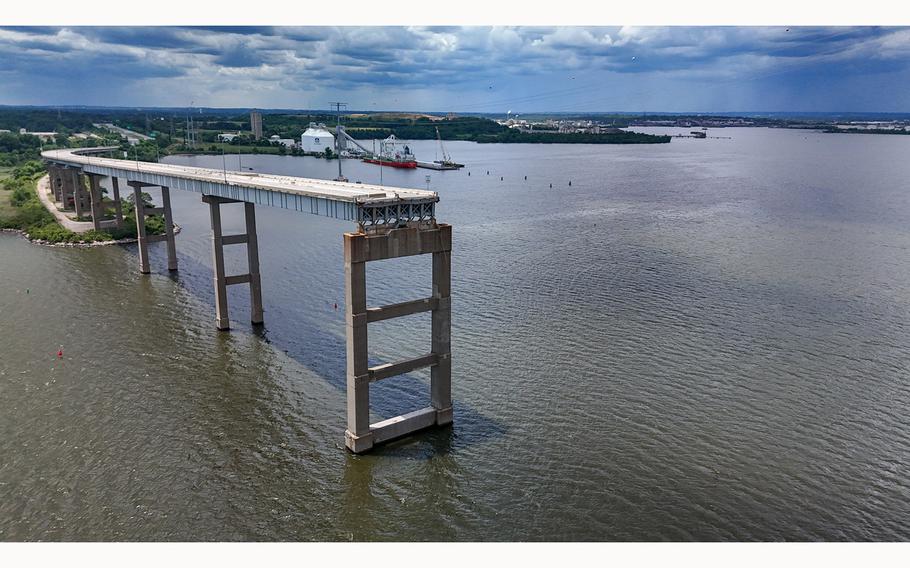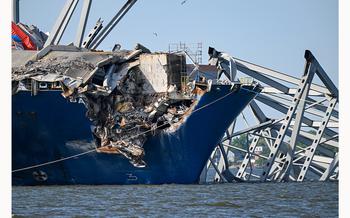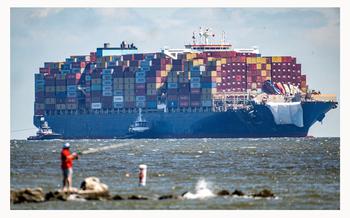
The ramp to the Francis Scott Key Bridge is seen on the southwest side of the Patapsco River two months after the catastrophic bridge collapse. (Jerry Jackson/TNS)
BALTIMORE (Tribune News Service) — Wednesday marked three months since the container ship Dali lost power in the early hours of March 26 and ran into a support pier of the Francis Scott Key Bridge, knocking down the structure. The collapse killed six construction workers, partially blocked Baltimore’s shipping channel until June and eliminated one of three harbor crossings in the city, slowing vehicular traffic.
New bridge expected by 2028
The Maryland Transportation Authority’s goal is to open the bridge to all lanes of vehicular traffic “no later than October 15, 2028,” according to a request for proposals (RFP) it released May 31. The deadline for proposals was Monday and teams submitted their pitches to the authority, which owns the bridge. By mid- to late summer, a builder — likely a collection of companies — will be selected.
In the RFP, the authority stated that “incentives will be offered for earlier completion.”
The specifics of the bridge remain undetermined and will be decided by the transportation authority and the selected builder, but experts have predicted that it will be cable-stayed — a design that’s been popular in recent decades. The bridge is expected to last at least 75 years and have four lanes of traffic (two each way) like the old span.

A section of I-695 is still draped across the bow of the container ship Dali that cut apart a section of steel truss from the Francis Scott Key bridge. (Jerry Jackson/TNS)
Officials have not yet said whether the new structure would have the same name as the old one.
Biden pledged to pay for it
The bridge is expected to cost roughly $1.7 billion and Democratic President Joe Biden has pledged that the federal government will completely pay for it. Maryland’s congressional leaders introduced a bill in April that specifies the federal government will pay 100% of the cost, but the bill has yet to pass.
The government would later be able to recoup at least some of the funds from third parties — from insurance or as a result of litigation.
In the immediate aftermath, officials estimated cleanup would cost about $50 million, but the Army Corps of Engineers and the Coast Guard spent roughly $160 million clearing the primary shipping channel into Baltimore. Maryland’s Board of Public Works will next week consider a $50 million contract with the construction company Skanska, which cleared debris outside that channel.
NTSB investigation ongoing
What caused the 984-foot Dali to lose power and run into the bridge remains under investigation. The National Transportation Safety Board, which will likely finish its analysis next year, said Monday that it is looking into an electrical component — about the diameter of a soda can — on the massive ship.
Dali moves south
After the collapse, the Dali spent roughly two months grounded in the shipping channel, tangled with bridge wreckage. It was refloated and moved to the Port of Baltimore by five tugboats last month. This week, it sailed under its own power, going under the Chesapeake Bay Bridge near Annapolis and on to Norfolk, Virginia.

The container ship Dali approaches the Chesapeake Bay Bridge on its way to Norfolk as a man fishes at Sandy Point State Park. Ninety days ago the ship hit a support pier of the bridge causing a catastrophic collapse. (Jerry Jackson/Staff) (Jerry Jackson/TNS)
The 100,000-ton vessel, with crunched containers still on its damaged bow, was assisted by four tugboats and two other vessels as it made the 23-hour journey to Virginia, where it will receive extensive repairs.
Some crew depart
Of the original 21 crew members aboard the Dali at the time of the collapse, who are from India and Sri Lanka, 10 were granted permission to return home. The remaining crew will stay in the Baltimore area for the time being.
Four of the crew members, given their familiarity with the vessel, traveled alongside a replacement crew to Virginia, with plans to return to Baltimore later.
©2024 The Baltimore Sun.
Visit at baltimoresun.com.
Distributed by Tribune Content Agency, LLC.